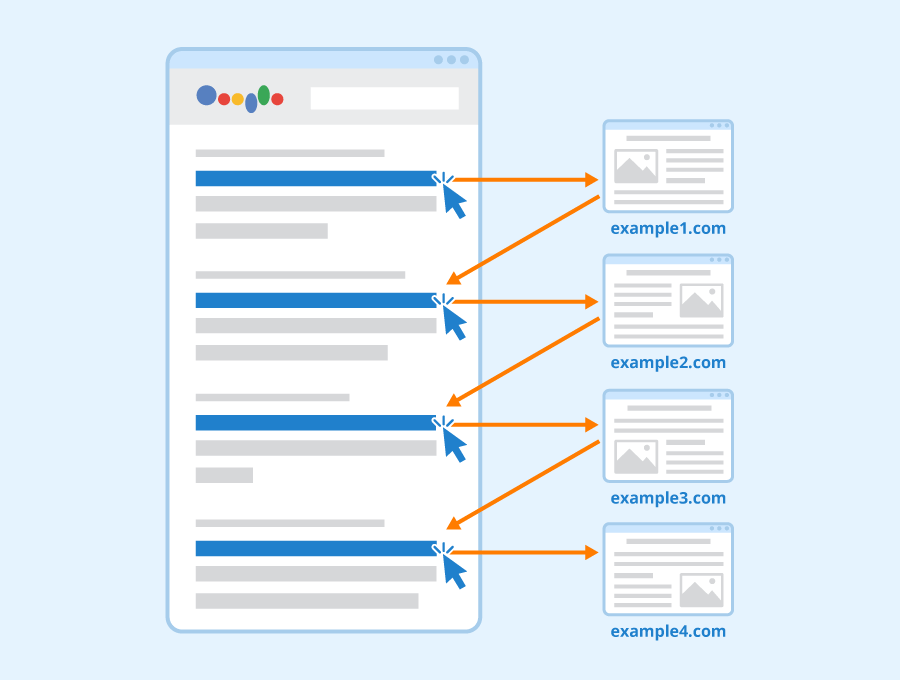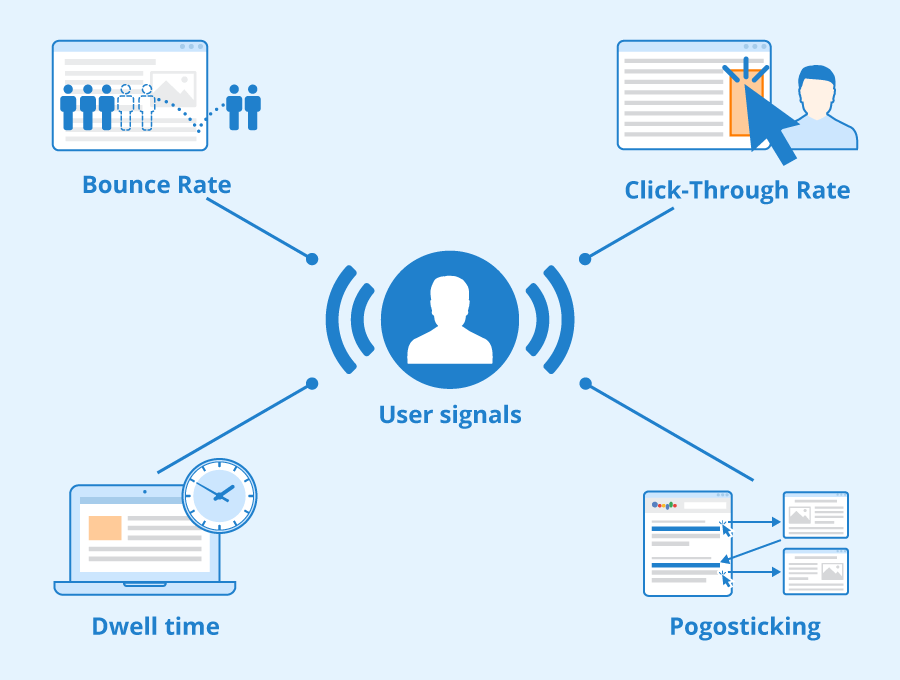
Do you love the expectation vs. reality memes?
I am sure you do. I love them too.
But have you ever thought about what the reason behind their popularity is?
It is because they humorously sum up how it feels when we think things would happen in a certain way, only to find out that they are awfully different.
In short, a total disappointment.
The same disappointment kicks you hard when you enter a site and immediately realize it doesn’t answer your query.
You keep jumping from one site to another until you find your answer. That’s what is pogo sticking in SEO.
If you are clueless about what it is, then I would advise you to learn more about it.
Knowing more about it would help you reach your audience or users and communicate with them the right way.
So, let’s dig deep and find out how seriously you should take pogo sticking and whether it is a google ranking factor or not.
What is pogo sticking in SEO?
Pogo sticking happens when search engine users navigate back and forth between several result pages without sticking longer to any of them.
Let me simplify this concept with an example.
Suppose you are searching for “best nutrition for glowing skin”, and you click on the first result but it’s not exactly what you are looking for. Hence you immediately go back to SERP to find results that cater to your needs.
Many SEOs dread pogo sticking believing Google tracks this user behavior and penalizes the website for failing to engage their audience for longer.
Keep reading this article to know whether Google actually penalizes your site for pogo sticking, why you should avoid it, Is pogo sticking is a Google ranking factor, and how can you avoid it.
I can totally understand if you are confusing pogo sticking with the bounce rate. Allow me to clear up your confusion.
Pogo sticking vs bounce rate
There is a difference between pogo sticking and bounce rate
- Pogo sticking happens when users go to a site from SERP and quickly return to the SERP. The users immediately find out that the page is not providing whatever they were searching for.
- Bounce rate, on the other hand, is when users enter a site from SERP and then stay there for a while but do not take any action like viewing other pages, clicking a link, buying any item, or filling in a form.
- For instance, if you read my article and leave this page without any other action that will count as a bounce rate.
- But a high bounce rate isn’t always a negative indicator. It means though the visitors did not go any deeper, they stayed for a while and found an answer to their queries.
- They might have bookmarked the page or shared it with friends and family but did not read any further resulting in a bounce.
- Hence, in case of a bounce rate the user may or may not be satisfied with the page or site.
- Pogo sticking and bounce rate are terms coined to measure dwell time (from the moment a user clicks on a link to the moment they return to the SERP). Pogo sticking has an extremely short dwell time, while bounce rates may have both high and low dwell time.
What does pogo sticking say about your site?

Pogo sticking says a lot about users’ behavior. If most of your visitors are pogo sticking after visiting your site it indicates that whatever they are expecting your site has failed to provide that to them.
Most importantly, Google can tell when your users are unhappy and to solve that it has created the “people also search for” box.
What are the common reasons for pogo sticking?
Stepping into the shoes of your website users is the best way to understand the reason behind pogo sticking.
Now, imagine you are a user and think about what search you can perform to make your website appear in the search results.
In the case of pogo sticking, the visitors realize that your search is not providing what they are asking within a few seconds after clicking on it. But there are numerous things that can go wrong within those 4-5 seconds. The reasons can be of 2 types –
a) Content-related
b) Non-content-related
Let’s check both
Content-related
- Clickbait
- Grammatical goofs and errors
- Pushy signups covering the content
- Outdated content
- Spammy content
- Headline not matching with meta description
- Buried information
Non-content-related
- Slow loading of the page
- Irritating pop-ups
- Videos on autoplay
- Ambiguous design
- Frequent redirections
- The searcher is simply browsing around
What are the best practices to avoid pogo sticking?

There can be innumerable reasons for pogo sticking. But let me tell you about some of the best tips and tricks to stay away from it.
Make your site load faster
When your site takes a lot of time to load, users lose their patience and skip to the next site. And if your competitor’s site loads faster, your users will go to it.
The competition is cut-throat and a slow-loading site can further pull you back.
Luckily, you can check the loading time of your website and learn why your site is loading slowly using PageSpeed Insights and various other tools.
Give a better user experience
Investing in an excellent design can never be a bad idea. No, you are not participating in a design competition, so keep it simple, too.
A recent study suggested that people take around 0.05 seconds to decide whether they like or dislike your site and whether they should stay or simply leave.
This clearly shows that users’ experience is a make-or-break aspect for your site’s success. People will obviously try to skip a website that is hard to use or navigate.
To provide the best experience to the users, keep it as simple as possible. Make the layout clear, functional, and consistent.
Also, do not forget to optimize your website for other devices like tabs and mobiles.
Follow the inverted pyramid method in content creation
Keep the “need to know” part of the content above the “nice to know” part. You should try this method not because I am advising you but because it is a tried and tasted journalistic method.
Update content regularly
Searchers understand which content is up-to-date and which one is outdated. If they sense that you have outdated content they would leave your site immediately.
Hence, spend more time updating and improving the quality of your older content.
Add table of content
If you are writing pillar content or any sort of long-form content, a table of contents will help the user find what they were searching for and skip the parts they don’t want to read.
That way they won’t get overwhelmed by the information you have bombarded them with and jump to the SERP.
Show expertise, authoritativeness, and trustworthiness (E-A-T)
E-A-T is an SEO concept that can take your website to places. Here, expertise means having a thorough knowledge of a particular subject or field.
In short, content is created by an expert. Hence, either you are an expert yourself or you hire an expert to create content. You can also invite experts to guest post for you.
You can flaunt your authoritativeness by showing your credentials like academic credentials, professional experience, and the talks and seminars where you spoke.
You will build trust among your users by providing them with content that is factual and up-to-date.
Use internal linking
Trust me, this is a simple but effective way to keep the users longer on your website. This link lets user dig deeper into the website and make them stay longer. But you need to make them extremely relevant so that the users find more information on their queries.
Is pogo sticking a ranking factor?

You will heave a sigh of relief after learning that Google’s John Mueller has revealed that Pogo sticking is just a user behavior and not a signal when it comes to search engine results.
He added, “When we look at our algorithms overall when we review which algorithm changes that we want to launch, we do look into how users react to these changes.
But that’s something we look at across millions of different queries, and millions of different pages, and kind of see in general if this algorithm is going the right way or is this algorithm going in the right way.
But for individual pages, I don’t think that’s something worth focusing on at all.”
Conclusion
Though pogo sticking is not a ranking factor considering the zillions of possible reasons for searchers to jump between websites and SERPs, it tells a ton about your website users’ behavior. Hence, if you want them to stay on your site for longer, make your content more engaging and relevant.
And let me know whether the tips and tricks mentioned above work for you or not by leaving a comment below.
FAQs
What is dwell time in SEO?
Dwell time is the amount of time a user spends on a webpage before going back to the SERP.
What is a good session duration?
As per contentsquare.com, an average user spends around 4 minutes and 24 seconds per visit on a site irrespective of any industry.
What are the bounce rate and dwell time?
Bounce rate, on the other hand, is when users enter a site from SERP and then stay there for a while but do not take any action like viewing other pages, clicking a link, buying any item, or filling in a form.
For instance, if people read my article and leave this page without any other action that will count as a bounce rate.
Dwell time is the amount of time a user spends on a webpage before going back to the SERP.
What is the page size limit for Googlebot crawlers?
Googlebot crawlers can crawl the first 15 MB of an HTML file and also support text-based files. The other sources and references like images, videos, and JAVAScripts are crawled separately. It considers the first 15 MB of the file for indexing.


